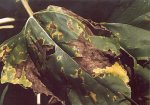Now we move on to the tree killer
Verticillium Wilt. The really bad fungus.
I am happy to say none of these pictures are mine....Thank God.
Verticillium Wilt
Verticillium spp. attack a very large host range including more than 350 species of vegetables, fruit trees, flowers, field crops, and shade or forest trees. Most vegetable species have some susceptibility, so it has a very wide host range. A list of known hosts is at the bottom of this page.
The symptoms are similar to most wilts with a few specifics to
Verticillium. Wilt itself is the most common symptom, with wilting of the stem and leaves occurring due to the blockage of the xylem vascular tissues and therefore reduced water and nutrient flow. In small plants and seedlings,
Verticillium can quickly kill the plant while in larger, more developed plants the severity can vary. Some times only one side of the plant will appear infected because once in the vascular tissues, the disease migrates mostly upward and not as much radically in the stem. Other symptoms include stunting, chlorosis or yellowing of the leaves, necrosis or tissue death, and defoliation. Internal vascular tissue discoloration might be visible when the stem is cut.
Once the pathogen enters the host, it makes its way to the vascular system, and specifically the xylem. The fungi can spread as hyphae through the plant, but can also spread as spores.
Verticillium produce
conidia on conidiophores and once conidia are released in the xylem, they can quickly colonize the plant. Conidia have been observed traveling to the top of cotton plants, 115 cm, 24 hours after initial conidia inoculation, so the spread throughout the plant can occur very quickly. Sometimes the flow of conidia will be stopped by cross sections of the xylem, and here the conidia will spawn, and the fungal hyphae can overcome the barrier, and then produce more conidia on the other side.
A heavily infected plant can succumb to the disease and die. As this occurs, the
Verticillium will form its survival structures and when the plant dies, its survival structures will be where the plant falls, releasing inoculates into the environment. The survival structures will then wait for a host plant to grow nearby and will start the cycle all over again.
Besides being long lasting in the soil,
Verticillium can spread in many ways. The most common way of spreading short distances is through root to root contact within the soil. Roots in natural conditions often have small damages or openings in them that are easily colonized by
Verticillium from an infected root nearby. Air borne conidia have been detected and some colonies observed, but mostly the conidia have difficulty developing above ground on healthy plants. In open channel irrigation,
V. dahliae have been found in the irrigation ditches up to a mile from the infected crop.
Without fungicidal seed treatments, infected seeds are easily transported and the disease spread, and
Verticillium has been observed remaining viable for at least 13 months on some seeds. Planting infected seed potatoes can also be a source of inoculum to a new field. Finally, insects have also been shown to transmit the disease. Many insects including potato leaf hopper, leaf cutter bees, and aphids have been observed transmitting conidia of
Verticillium and because these insects can cause damage to the plant creating an entry for the
Verticillium, they can help transmit the disease.
In
Verticillium, the symptoms and effects will often only be on the lower or outer parts of plants or will be localized to only a few branches of a tree. In older plants, the infection can cause death, but often, especially with trees, the plant will be able to recover, or at least continue living with the infection. The severity of the infection plays a large role in how severe the symptoms are and how quickly they develop.
As Verticillium spreads more quickly in weaker plants, follow these sound cultural practices:
· Prune dead branches to discourage infection by other fungi. Disinfect tools between cuts in a 10 percent solution of household bleach.
· Water generously, especially during dry periods.
· Apply modest amounts of slow-release fertilizer, low in nitrogen and high in potassium.
· Mulch to maintain soil moisture, keep soil temperatures moderate and minimize chances of root injuries.
· Avoid gardening under a Japanese maple, as damage to the roots can be an entry point for Verticillium wilt.
· Don’t use wood chips from infected trees.
· Because the Verticillium fungus can survive in the soil for 10 years, do not move soil or debris from areas of known infection.
· Fungicides are not effective for control, because tree roots inevitably grow beyond the treated area.
· Seek guarantees from nurseries or suppliers that the stock you purchase is Verticillium-free. Replace severely infected trees with nonsusceptible species such as yew or conifer.
Disease incidence is influenced by cultural care and environmental conditions, so homeowners who choose to beautify their gardens with Japanese maples must take precautions against the establishment and spread of Verticillium wilt.
Chantal Guillemin is a Contra Costa Master Gardener.
Master Gardeners
The Master Gardener programs are UC Cooperative Extension, county-based volunteer organizations dedicated to providing research-based gardening information to home gardeners. They love sharing information and answering questions.
Contra Costa Master Gardeners, 925-646-65
Susceptible plants
Maples, Most all stone fruits,(Ume) and various elms
Immune plants
Juniper, Pine, Pyracantha, Hackberry, Boxwood, Hornbeam, Oaks, Yew, Zelcova and Hawthorn
Leaves look much the same as Anthracnose, but has much more yellow in the early stages while Anthracnose goes right to brown and black.


As the disease progresses large portion of the tree will die off, starting with entire branches.


Entire branches and even whole trunks will turn black.

The autopsy will show dark growth rings of rotton tissue inside the branches and trunk.





































